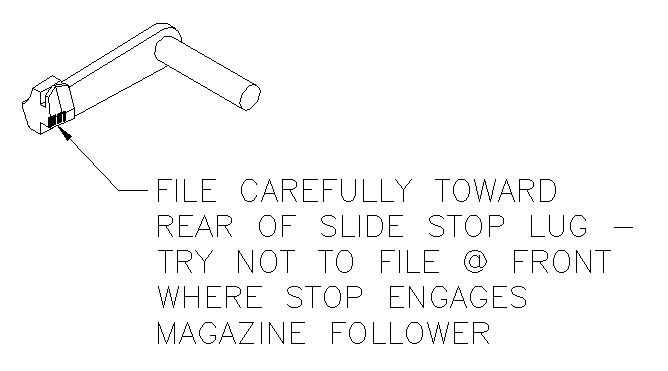bamaranger
New member
I've bought a budget 1911 pattern .45 acp pistol, a Tisas. Upfront, I knew it was a clone, not a Colt or Kimber, etc, and expected to tweak and it would be a project/hobby gun. Overall, I am more than satisfied, but am experiencing a consistent failure, premature slidelock.
Typically on a partial magazine......and it would seem on all my magazines, including a new Wilson and another Wilson near new. Most usually on factory W-W 230 gr ball ammo. My reloads using a 230 gr lead RN, are milder and do not seem to cause as many pre-locks.
What seems to be happening is that the nose of a live cartridge is nudging the lug for the slide stop lever while feeding up. Frequently, on a failure, the slide will be locked open, and a round will be about 1/3 out of the mag, just up the ramp. With a full mag, there seems to be enough tension in the mag box & stack of cartridges, that the rounds do not get to moving about and the fails do not occur. My milder reloads similarly do not seem to jar cartridges around in the mag box as much, thus fewer fails with them, but it does still occur.
Seems a common 1911 issue. What to do?
-Relieve the inner lug on the slide stop (not a lot to work with)?
-Dimple the face of the slide lock lever where the plunger bears?
-I suspect changing bullet styles to a SWC may help, none on hand, and I'd really like this gun to shoot hardball reliably, I've got a lot on hand.
-This was a budget buy, I don't want to sink money into it for a new Wilson lever or other high end new part. My expectations are not that high, but this stumble seems like it could be resolved.
Typically on a partial magazine......and it would seem on all my magazines, including a new Wilson and another Wilson near new. Most usually on factory W-W 230 gr ball ammo. My reloads using a 230 gr lead RN, are milder and do not seem to cause as many pre-locks.
What seems to be happening is that the nose of a live cartridge is nudging the lug for the slide stop lever while feeding up. Frequently, on a failure, the slide will be locked open, and a round will be about 1/3 out of the mag, just up the ramp. With a full mag, there seems to be enough tension in the mag box & stack of cartridges, that the rounds do not get to moving about and the fails do not occur. My milder reloads similarly do not seem to jar cartridges around in the mag box as much, thus fewer fails with them, but it does still occur.
Seems a common 1911 issue. What to do?
-Relieve the inner lug on the slide stop (not a lot to work with)?
-Dimple the face of the slide lock lever where the plunger bears?
-I suspect changing bullet styles to a SWC may help, none on hand, and I'd really like this gun to shoot hardball reliably, I've got a lot on hand.
-This was a budget buy, I don't want to sink money into it for a new Wilson lever or other high end new part. My expectations are not that high, but this stumble seems like it could be resolved.

